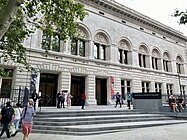English: Edward VI and the Pope: An Allegory of the Reformation. National Portrait Gallery, London.
Inscribed on open book, centre left: "THE WORDE OF THE LORD ENDURETH FOR EVER"; on ribbons of pope's tiara: "IDOLATRY" and "SUPERSTIC[ION]"; on pope's chest: "ALL FLESHE IS GRASSE" ('All flesh is grass,' from
Isaiah 40:6, meaning the body is ephemeral); lower left in the golden frame: "POPS" and "FEYNED HOLINE[SS]".
The painting represents the handing over of power from
Henry VIII to his son
Edward VI. Henry lies in bed, and Edward sits on a dais beneath a cloth of state, with a book at his feet containing a text from Isaiah, which falls onto the slumped figure of a pope. The pope points a triple cross towards two monks, lower left, who pull on chains attached to Edward's dais. Standing to Edward's side is a figure identified as his uncle,
Edward Seymour, 1st Duke of Somerset and Lord Protector. Other figures on the right represent Edward's Privy Council and include the
Archbishop of Canterbury Thomas Cranmer (in white), the
Lord Privy Seal John Russell (grey beard), and
William Paget (forked beard), the Comptroller of the King's Household. At top right is a picture of
iconoclasm, the smashing of idols, an activity approved of by Cranmer and many religious reformers.
The scholarship on this painting is conflicted. It was once taken for granted that the painting was contemporary with the succession of Edward VI in 1547. Dr Margaret Aston, in
The King's Bedpost, a book devoted to this painting, has claimed instead that the work could not have been painted before the late 1560s. She bases her theory on the similarities between the sphinx bedpost (foot of Henry's bed) and between the column in the iconoclastic scene and those in two engravings of pictures by
Maerten van Heemskerk produced between 1564 and 1569. Roy Strong has accepted Aston's redating of the picture but regards many of her views on the painting's significance as conjectural. Jennifer Loach has challenged Aston's reading of the picture, disputing her identification of some of the figures (she accepts the ones mentioned above, however), and believes that the painting was a piece of contemporary propaganda, created during Edward VI's reign. (References: Margaret Aston,
The King's Bedpost. Reformation and Iconography in a Tudor Group Portrait, Cambridge, 1993; Roy Strong,
The Tudor and Stuart Monarchy. Pageantry, Painting, and Iconography, Woodbridge (UK), 1995; Jennifer Loach,
Edward VI, Yale University Press, 1999.)
Français : Édouard VI [d'Angleterre] et le pape : une allégorie de la Réforme, la National Portrait Gallery à Londres.
Inscrit dans le livre ouvert: « the worde of the Lord endureth for ever» (la parole du Seigneur demeure pour toujours) ; sur la tiare: « idolatry » et « superstic[ion] » (superstition) ; sur la poitrine du pape: « All fleshe is grasse » (Toute chair est de l'herbe (
Isaiah Isaïe 40:6)), signifiant que le corps n'est qu'éphémère] ; autour de la main : « pops » (pape) et « feyned holine[ss] » (sainteté feinte).
Le garçon dans le trône est
Édouard VI. Dans le lit s'assoit son père, Henri VIII, qui lui transfère son pouvoir.
À droite est un dessin de l’
iconoclasme protestant, montrant des hommes déstruisant une statue.







